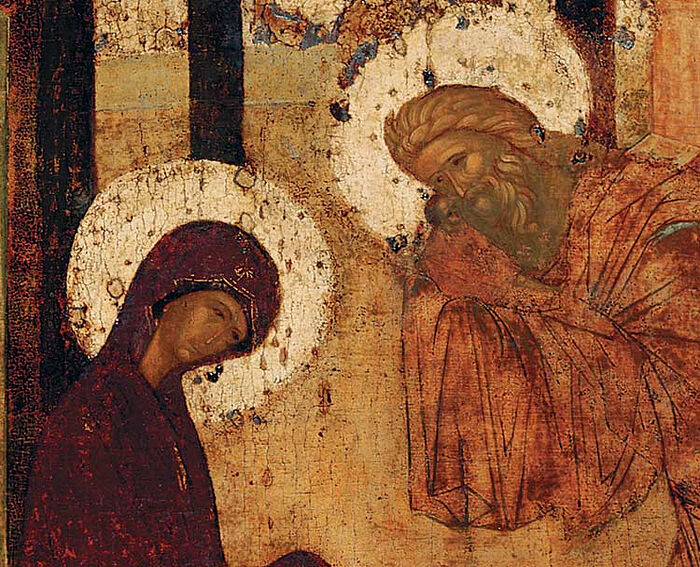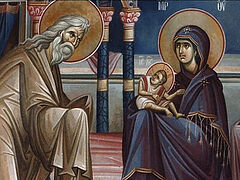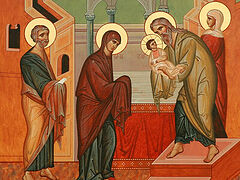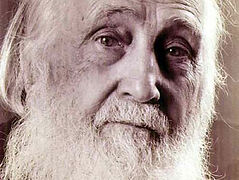We Christians know that the greatest milestone in world history, its greatest miracle, is the appearance in the world of the God-Man Christ. Therefore, all significant events of His earthly life, such as Christmas, Baptism, Transfiguration, Entry into Jerusalem and others, are filled with great meaning and are festive events for us. Undoubtedly, the feast of the Meeting, which is being celebrated today, is among them.
The events of this feast are known to us from the Gospel. When the infant Christ was forty days old, He was brought by His Most Pure Mother and the righteous Joseph to the temple in Jerusalem to fulfill the Old Testament rite of consecration to the Lord. They were met in the temple by the righteous Simeon the God-receiver. Simeon was very old and had been promised by the Holy Spirit that he would not die until he had seen the Messiah come into the world. And so, when Mary brought the Child, the Holy Spirit revealed to Simeon that this baby was the Messiah, the Son of God and Savior of the world. With fear and trembling, as well as with great joy, Simeon took the Child in his arms and uttered his famous words: Now lettest thou thy servant depart in peace, O Lord…
Brothers and sisters, the word sretenie means “meeting” in Slavonic. Who met with whom today? God met with man, the Bridegroom met with the bride, the Lord met with the earthly Church. The history of waiting for this meeting, and therefore the history of today’s feast, begins literally from the first days of the existence of the world—from Adam and Eve. We know from the Bible that when Adam and Eve were expelled from Paradise and separated from God, the Lord promised them that a Messiah would come to earth one day, and would save people from damnation and death and bring them back to Paradise. From that time, the expectation of this promised meeting, or in Slavonic, sretenie, begins. It took many centuries and millennia before God’s promise to the first parents was fulfilled. So that people would not forget about the upcoming meeting and would not stop waiting for it, God repeatedly reminded them of it through the prophets.
We know that in the Old Testament times, of all the peoples of our planet, only one knew the true God and had the true faith—the Jewish people. The Jews had Solomon’s Temple, the only temple of the true God on earth at that time. The Jews called it “The House of the Lord” and believed that the Lord Himself would one day come to His house. This was stated in the sacred prophetic books. For example, the Prophet Malachi had written: Behold, I will send my messenger, and he shall prepare the way before me: and the Lord, whom ye seek, shall suddenly come to his temple, even the messenger of the covenant, whom ye delight in: behold, he shall come, saith the LORD of hosts. The people of God were waiting intensely for this coming, and this expectation was the main content of their entire Old Testament religion.
The temple itsefl seemed to be expecting this. It is very significant, for example, that the altar of the Old Testament temple faced west. The altars of our Christian churches always face east, and the entrance to them is always from the west. In Solomon’s temple, the opposite was true—it had an entrance from the east. It was as if the temple were waiting for its Master, its God and Lord, Who was to come from the east, from the heavenly land of light. For the prophets in their books often compared the coming Messiah with the rising sun, a star, or even simply light. The light and all the luminaries come from the east, and therefore that is where the entrance of the temple in Jerusalem faced.
Solomon’s temple waited a long time for the coming of its Lord. Exactly a thousand years passed before the prophetic scriptures were fulfilled and the event that we celebrate today took place—the coming of God into the temple and His meeting with His people. It is very symbolic that after the coming of Christ, our temples, the direct heirs of Solomon’s temple, turned the altar to the east. This means that the temple of Solomon fulfilled its purpose. It waited for the Messiah and the Lord, who by His coming revolutionized our world and enlightened people with the light of truth. Therefore the temples of God turned one hundred and eighty degrees, and Christians no longer pray facing west, as in Solomon’s temple, but facing east.
So, the Lord came to the temple in Jerusalem, thus fulfilling the prophecies of the Old Testament. Let us see, however, who met Him in the temple? The Gospel mentions the names of only two people who met the Lord. These are Simeon the God-receiver and Anna the Prophetess. Both people were great righteous ones who devoted their entire lives to serving the Lord and waiting for the Messiah. It is said of Simeon that the Holy Spirit dwelt in him, and of Anna it is said that she did not leave the temple, serving God by fasting and prayer day and night. From here it is clearly seen to whom the Lord reveals Himself and who can meet Him. Only the righteous, only people of high spiritual life are capable of meeting with the Lord.
One should also pay attention to the words of Simeon, for mine eyes have seen Thy salvation. “Thy salvation,” that is, the salvation of God, was often referenced in the books of the Old Testament as the coming Messiah.
For example, King David’s prayer for the enlightenment of all the peoples of the earth: God be merciful unto us, and bless us, And cause his face to shine upon us; That thy way may be known upon earth, Thy salvation among all nations (Ps. 67:1-3). Here, according to the interpretation of the holy fathers, “Thy salvation” should be understood as Christ Himself. Therefore, Simeon’s words clearly indicate that the Child brought to the temple is the long-awaited Messiah.
In addition, in Hebrew, the Savior’s name, Jesus, comes from the word “Yeshua,” which means “salvation,” and therefore the phrase mine eyes have seen Thy salvation sounds literally in Hebrew as “my eyes have seen Thy Jesus.” Also, the words of David mentioned, that they may know Thy salvation among all nations, literally sound like, “that they may know Thy Jesus in all nations.” Such is the interpretation of these words; such are the hidden meanings of the Holy Scripture.
When the Lord came to the Jerusalem temple, He filled it with Himself, with His presence. He sanctified it, confirmed and blessed it as the place of meeting between man and God. We know from history that Solomon’s Temple was living out its last years at that time. It would not be long before it was razed to the ground by the Roman general Titus. But from it, like shoots from their root, Christian temples, temples of the New Testament, would grow and spread throughout the earth, where people would be able to meet God—through prayer, through Grace, through the Communion of the Body and Blood of Christ.
Dear brothers and sisters, we are called to such a meeting, to such a meeting with the Lord. May the Lord guide us in this world so that at the end of our journey, having lived our lives in a Christian way and having pleased Christ, we may say together with the righteous Simeon the words of a wanderer returning to his heavenly Homeland: Now lettest thou thy servant depart in peace, O Lord, according to Thy word. Amen.




